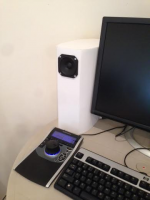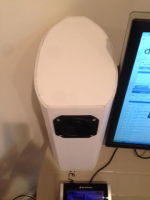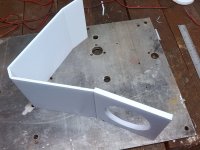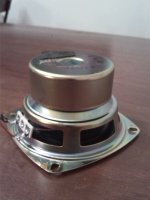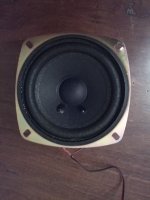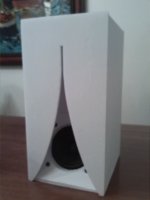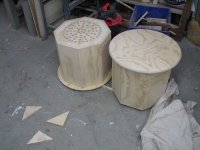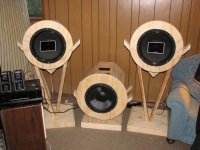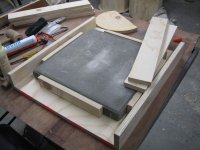Don Hills,
Yes you did suggest this. I couldn't remember who - but when I saw Grandcalmar do it on a box it for me thinking again. Isn't anyone going to ask how I for the exact volume of an odd shape?
Yes you did suggest this. I couldn't remember who - but when I saw Grandcalmar do it on a box it for me thinking again. Isn't anyone going to ask how I for the exact volume of an odd shape?
Sound Clip of TC9FD DCR
Here is the Vifa DCR sitting next to my monitor - makes the ultimate computer speaker! The height is just right at ear level and the rear firing bass port integrates well with the back wall for some enhancement. I applied a -6dB BSC shelf from 1 kHz on up using Jriver and played a song from YouTube (so not the best source here but gives you an idea of the sound). Note that this is in mono (left channel only) and powered by a tiny Sure 8 watt TPA3110D2 amp. I think they sound very nice - the frequency range from 200 Hz and above is, well, very TC9FD like - which is to say outstanding, essentially reference quality monitor like with very good detail and transparency. The bass provided by the DCR below 200 Hz seems very balanced and extension feels like it really is a good 55 Hz to 60 Hz. I have been spoiled by the bass from the Nautaloss because of course, a 3.5 in driver trying to drive 50 Hz is not going to be anything like qnty 4 x 6.5 in drivers into a sealed cabinet. But nonetheless, very enjoyable at moderate SPL's - so for near field it works well. Measurements to come later, possibly in a dedicated thread if there is enough interest.

Here is a detailed top view so you can see the profile better:
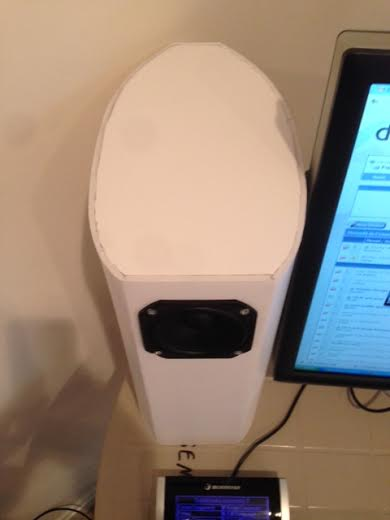
Here is the Vifa DCR sitting next to my monitor - makes the ultimate computer speaker! The height is just right at ear level and the rear firing bass port integrates well with the back wall for some enhancement. I applied a -6dB BSC shelf from 1 kHz on up using Jriver and played a song from YouTube (so not the best source here but gives you an idea of the sound). Note that this is in mono (left channel only) and powered by a tiny Sure 8 watt TPA3110D2 amp. I think they sound very nice - the frequency range from 200 Hz and above is, well, very TC9FD like - which is to say outstanding, essentially reference quality monitor like with very good detail and transparency. The bass provided by the DCR below 200 Hz seems very balanced and extension feels like it really is a good 55 Hz to 60 Hz. I have been spoiled by the bass from the Nautaloss because of course, a 3.5 in driver trying to drive 50 Hz is not going to be anything like qnty 4 x 6.5 in drivers into a sealed cabinet. But nonetheless, very enjoyable at moderate SPL's - so for near field it works well. Measurements to come later, possibly in a dedicated thread if there is enough interest.

Here is a detailed top view so you can see the profile better:

Attachments
Last edited:
Don Hills,
Yes you did suggest this. I couldn't remember who - but when I saw Grandcalmar do it on a box it for me thinking again. Isn't anyone going to ask how I for the exact volume of an odd shape?
Did you fill it with water to get the exact volume😉
Regards
I normally would have used a planimeter to measure the area of the top/bottom but have since lost it since I loaned it to a friend 15 years ago and he still hasn't returned it.
I used the "weigh a piece of paper" method. I have a sensitive gram scale (which comes in handy for speaker TS measurements too) and compared the weight of the unknown CSA shape to a reference piece of paper with known area then calculated the unknown area.
Filling with water would have worked but it would have been the end of the speaker 🙂
I used the "weigh a piece of paper" method. I have a sensitive gram scale (which comes in handy for speaker TS measurements too) and compared the weight of the unknown CSA shape to a reference piece of paper with known area then calculated the unknown area.
Filling with water would have worked but it would have been the end of the speaker 🙂
I'd have measured and weighed the piece of foam board before cutting the end piece from it, then weighed again after cutting...
Very nice X - I like it.😛
On the weekend I knocked up another mini-Karlsonator 0.4X for some 4 inch drivers I scavenged from a cheap RCA surround system. I used the score and bend technique to get the sides and top out of one FC sheet, leaving me to only glue the bottom and back. I also did the same for the internals - hopefully the photo is good enough to see - meaning it was a simple matter of gluing the one shaped piece down. It worked very well: greatly speeds up the process, more accurate (assuming a good job with the score marks) and uses less glue.
Cheers!
On the weekend I knocked up another mini-Karlsonator 0.4X for some 4 inch drivers I scavenged from a cheap RCA surround system. I used the score and bend technique to get the sides and top out of one FC sheet, leaving me to only glue the bottom and back. I also did the same for the internals - hopefully the photo is good enough to see - meaning it was a simple matter of gluing the one shaped piece down. It worked very well: greatly speeds up the process, more accurate (assuming a good job with the score marks) and uses less glue.
Cheers!
Attachments
Nice work on the score and fold technique. I think this may become the mainstay in FC construction technique in the future! Are these 0.4x Karlsonators for your wife?
You guessed it😉
Did you finish the 0.4x Karlsonators for your wife? Curious how the non specific RCA drivers worked out.
Did you finish the 0.4x Karlsonators for your wife? Curious how the non specific RCA drivers worked out.
Yes, finished. Built one just to see really and try out the score and fold construction. Was very pleasantly surprised with the sound so decided to build the second. They sound great, however when I do an A to B with the vifa version, the vifa version sounds better. The vifa has slightly more bass extension and more clarity in the mids - it's overall tighter.
If I get time I'll measure the TS parameters of the spare RCA (or EAH) driver - it would be interesting to see how it models.
Attachments
Grandcalmar,
Nice looking box there! You even did reverse mount - how do you take driver out? Get me TS params and I will model it.
Nice looking box there! You even did reverse mount - how do you take driver out? Get me TS params and I will model it.
hey X - maybe for fun you can make a Sapkowski enclosure out of foam Patent US5552569 - Exponential multi-ported acoustic enclosure - Google Patents
one form
one form
An externally hosted image should be here but it was not working when we last tested it.
Last edited:
Sapkowski gave no credit to Karlson. Karlson's first "Acoustic Transducers" patent filed in 1951 allowed for use of holes as the aperture. Another prior-art patent pertinent to Sapkoski's would be one by Norman C. Fulmer. Another thing for someone to try in foam board would be Clement's "H-PAS" type. What's the easiest tool to model an H-PAS?
a Fulmer TQWT would look nice in foam board
http://www.google.com/patents/US2787332
a Fulmer TQWT would look nice in foam board
http://www.google.com/patents/US2787332
Last edited:
The first speakers I built ~ H-36" x W-24" X D-12" with a 10" Lafayette (Criterion) coax. The bottom half had like 48 holes in the 3/4" baffle. The designer claimed his approach would equal a standard port if one did the calculations. They were very soothe and responsive with no boom or peaks. Probably still have the plans somewhere in storage.
hey bcmbob - that sounds like it worked well - ~1967 i made a 5 cubic foot reflex tuned by 10 - 3/4" holes for a cheap Allied Knight (Jensen) 12" fullrange - it was ok til I tried to tune it using a ducted port nomogram - then it boomed.
about a decade ago I tuned a 3.5 cubic foot box with 1/2" thick removable port panel with 43-3/8" holes - small signal tuning was ~41Hz. When feeding the 15" Peavey with 10 watts of sine, the port "wind" felt about like a box fan on low at 8 feet - I'm pretty sure very small distributed vents muck with the ability to reproduce a clean sine wave near fb. Hopefully music is mostly transient and moving in nature and doesn't excite distortion (?) I've heard speakers which could play sine around fb or nulls but fail miserably on music transients.
I've got 4-18" vented boxes which vent like the R-J but don't have that much aperture constriction. They're basically copies of a design which was published in Audio Engineering in the early 1950s. The builder used what I call "de-Qing" holes running from the outside wall though the inner duct panel. He used asbestos board for the baffle .....
imagine this with small holes drilled above and below the aperture and that they pass through the inner two ducts
GE had a distributed port cabinet article - this might be one of those cabinets
http://www.audiokarma.org/forums/showthread.php?t=475237
about a decade ago I tuned a 3.5 cubic foot box with 1/2" thick removable port panel with 43-3/8" holes - small signal tuning was ~41Hz. When feeding the 15" Peavey with 10 watts of sine, the port "wind" felt about like a box fan on low at 8 feet - I'm pretty sure very small distributed vents muck with the ability to reproduce a clean sine wave near fb. Hopefully music is mostly transient and moving in nature and doesn't excite distortion (?) I've heard speakers which could play sine around fb or nulls but fail miserably on music transients.
I've got 4-18" vented boxes which vent like the R-J but don't have that much aperture constriction. They're basically copies of a design which was published in Audio Engineering in the early 1950s. The builder used what I call "de-Qing" holes running from the outside wall though the inner duct panel. He used asbestos board for the baffle .....
imagine this with small holes drilled above and below the aperture and that they pass through the inner two ducts
An externally hosted image should be here but it was not working when we last tested it.
GE had a distributed port cabinet article - this might be one of those cabinets
http://www.audiokarma.org/forums/showthread.php?t=475237
Last edited:
Grandcalmar,
Nice looking box there! You even did reverse mount - how do you take driver out? Get me TS params and I will model it.
Unfortunately, I can't take the driver out - I even glued the aperture in place!
I'll let you know once I've measured the spare driver - thanks.
Cheers!
- Home
- Loudspeakers
- Full Range
- Foam Core Board Speaker Enclosures?
